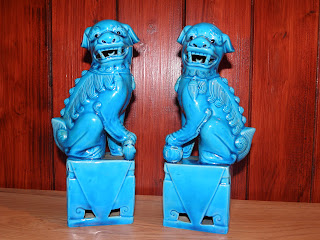I bought this pair of Chinese temple lions in Mercer and Sons, Blackburn, about twenty five years ago. Mercer's was the oldest shop in Blackburn, it opened in 1840, and was an old-fashioned hardware shop, which sold just about everything. Thanks to the credit crunch, it closed down in 2009.
Temple Lions, or Temple Dogs, guarded temples, tombs, palaces and other important Chinese buildings. Except they were never called 'dogs' in China - it's probably a mistranslation. In the West, they are often called Foo, or Fu, Dogs, again probably a mix-up in translation, and/or mis-interpreting the lion-form of the statues as representations of such Chinese dogs as the Chow-Chow and Shih Tzu.
They are really called shishi, Chinese for 'Stone Lion'. They come in pairs, male and female. The male, traditionally placed on the right, rests his right paw on a ball, symbolising the world, and represents the yang force. He guards the structure or building.
The female, standing on the left, has her left paw on a rolled-up cub representing the cycle of life, she represents yin, and guards the inhabitants of the building.
In Chinese, Shi means 'lion'. But Chinese is a tonal language, the pitch of the pronunciation of the sounds of the letters giving the meaning. Intonation also gives meaning to the sentence. This means words which are spelled the same can be pronounced differently, and have different meanings. So, the poem Lion-Eating Poet in the Stone Den, by the poet Yuen Ren Chao, reads thus : -
- Shíshì shīshì Shī Shì, shì shī, shì shí shí shī.
- Shì shíshí shì shì shì shī.
- Shí shí, shì shí shī shì shì.
- Shì shí, shì Shī Shì shì shì.
- Shì shì shì shí shī, shì shǐ shì, shǐ shì shí shī shìshì.
- Shì shí shì shí shī shī, shì shíshì.
- Shíshì shī, Shì shǐ shì shì shíshì.
- Shíshì shì, Shì shǐ shì shí shì shí shī.
- Shí shí, shǐ shí shì shí shī shī, shí shí shí shī shī.
- Shì shì shì shì.
When read with the correct intonation and pitch, this translates as : -
- In a stone den was a poet called Shi, who was a lion addict, and had resolved to eat ten lions.
- He often went to the market to look for lions.
- At ten o'clock, ten lions had just arrived at the market.
- At that time, Shi had just arrived at the market.
- He saw those ten lions, and using his trusty arrows, caused the ten lions to die.
- He brought the corpses of the ten lions to the stone den.
- The stone den was damp. He asked his servants to wipe it.
- After the stone den was wiped, he tried to eat those ten lions.
- When he ate, he realized that these ten lions were in fact ten stone lion corpses.
- Try to explain this matter.
What fun!
Here's another lion. I only have one of these, and I've no idea when and where I picked him up. I am on the look-out for a match, but haven't found one yet.
Take care buying any of these - I've seen modern ones being offered as antiques, for several hundred pounds.
'Foo', a nonsense word, appeared in the Smokey Stover cartoons by Bill Holman in the 1930s. In the 1940s, radar operators started to refer to indeterminate traces as 'Foo Fighters', and by 1944, allied pilots began to report unidentified fire-balls in the night skies over France and Germany, which they also called 'Foo fighters'. Some say the name comes from the French feu - 'fire'. Airmen on both sides soon began to report these objects, which followed their planes, but never engaged them. There is probably a perfectly rational explanation for the phenomena.
It wasn't until 1952 that the term U.F.O. (Unidentified Flying Object) was first used.




Ahhhhh Foo Fighters ;) xcx
ReplyDelete